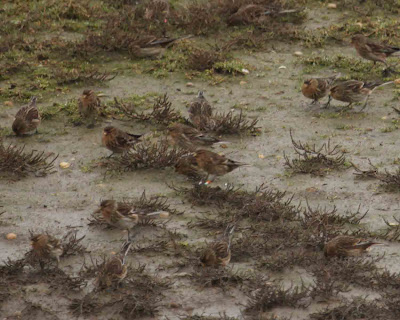
Waxwing, one of many during the second winter period of 2010.
Now that BT have finally got around to sorting out our Broadband connection I thought I would resume this blog with a brief look back at some birding highlights from last year.
2010 was dominated by my continued adjustment to family life and the demands of a young son and busy job. Nonetheless I still managed to see 199 species in the UK during the year which I think was a good effort.
The year got off to a good start with 83 species clocked on New Years Day including a Red Kite and Little Gull at Titchwell.
Spring started well with a visit to Lakenheath Fen where I saw the young Common Crane fledged there the previous year the first to be raised in the wild in the Fens for over four centuries.
Red Kite's popped up several times during the year, a sign of their welcome recovery as a breeding species. Perhaps the most surprising encounter I had with this enigmatic bird was of a flock of three drifting over Holme Marsh one April morning.
The other Bird of Prey highlight of the year was the increase in sightings of Peregrines in King's Lynn, although not guaranteed the prospect of a brief glimpse of one of these wonderful birds as you sit a traffic lights on your way to the station adds a certain something to a journey through town.
I only managed to see three or four Kingfishers during the year, a reflection of doing most of my birding on the North West Norfolk coastal strip. Of those Kingfishers that I did managed to see three were seen from my car, one on the Norfolk / Cambs border, one near Swanton Morley and one flying into a ditch on the outskirts of Lynn.
I did manage to see some reasonable sub rarities, including a flock of five Black Winged Stilts at Titchwell, where I also had in the same scope view one afternoon a Buff Breasted and a Pectoral Sandpiper. Holme produced some good birds including my second British Arctic Warbler and one memorable afternoon when in the space of two hours I saw Red Backed Shrike, Barred Warbler and Red Necked Phalarope.
Oddest sighting of the year was a Bittern lifting off from underneath a line of trees bordering a field in Titchwell, with not even a puddle for it to have been getting its feet wet in.
Trips to London for meetings meant that I had no problem in year ticking that exotic alien Ring Necked Parakeet whose raucous calls are a feature of St James's Park.
The year ended with a Waxwing invasion and I was lucky enough to bump into several flocks of these birds including one of 31 that flew over our house in Hunstanton whilst I was unloading the car late one Sunday afternoon.
Away from Norfolk a family holiday to Speyside and a chance to visit many favourite old haunts was wonderful. In the memory now six months on, what stands out are the immaculate freshly emerged Small Pearl Bordered Fritillaries, lots of Red Squirrels, Bottle Nosed Dolphins at Chanonry Point and 'pishing' in a couple of Crested Tits at Loch Garten. That and our Little Fella taking his first steps in Garten Wood.
All in all a good year. Here's hoping that 2011 is equally full of birds, wildlife, landscapes and memories.












 "They've made it again, Which means the globe's still working, the Creation's still waking refreshed, our summer's still all to come" from Swifts by Ted Hughes
"They've made it again, Which means the globe's still working, the Creation's still waking refreshed, our summer's still all to come" from Swifts by Ted Hughes



























